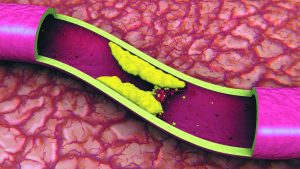Poor circulation, or PAD (peripheral artery disease), is caused by the buildup of fatty material inside the arteries.
Diabetes is linked to two conditions that increase the risk of amputation: peripheral artery disease (PAD), sometimes referred to as poor circulation, and diabetic neuropathy. While people know about these conditions, they don’t understand how serious they are and that they can lead to amputation.
Poor circulation, or PAD (peripheral artery disease), is caused by the buildup of fatty material inside the arteries. “If an artery is blocked, oxygen and nutrients can’t get to your nerves and muscles, causing them to cry out for help,” explained Dr. Diana Perry, of CIC Foot & Ankle in Flagstaff. “Cramping, burning, tingling, numbness or a sore that never gets better are telltale signs.” A non-healing wound is one of the most concerning issues, putting you at serious risk for amputation.
Sores that are not able to heal are what lead to complications. “If enough blood isn’t circulating, that sore isn’t getting everything it needs to heal,” said Perry. “This worries me, because if it’s not treated, a chronic wound can lead to an amputation.”
Living with diabetes puts you at increased risk. “High blood sugar and inflammation related to diabetes attacks your blood vessels and causes them to block with plaque,” said Rainwater. When this happens, your feet may feel cold, your legs may cramp during even a short walk, your skin may become very dry or thin and shiny, and a cut or blister just won’t heal.
If the signs are overlooked, or they are not diagnosed properly, they will continue to progress. “This serious condition must be identified by diabetic caregivers, because minimally invasive treatment can be lifesaving,” explained Rainwater. “If you get an amputation because you have PAD, your life expectancy is worse than if you had breast cancer or lymphoma. PAD is no joke.”
The good news is PAD is very treatable. Lifestyle changes, medication and minimally invasive procedures can help prevent PAD from progressing to dangerous consequences.
“Fortunately, this is something that we can fix,” said Rainwater. Using tiny tools and real-time imaging, Rainwater and other endovascular specialists at CiC are able to go into the bloodstream to access the blocked peripheral arteries, clear plaque away, and restore normal blood flow. Establishing blood flow reestablishes the oxygen and nutrient supply so healing can begin.
Patients are able to resume everyday living with almost no downtime and no overnight hospital stay. Medicare and most insurance plans cover the treatment.
Knowing why diabetes puts you at risk, recognizing the symptoms, and taking action helps you protect yourself. Diagnosing and treating PAD can mean the difference between saving or losing a limb, and in some cases, saving a life. FBN
By Reisha Zang
Reisha Zang is director of communication at CiC. You may contact her at 928-719-7400 or reisha.zang@ciccenters.com.





